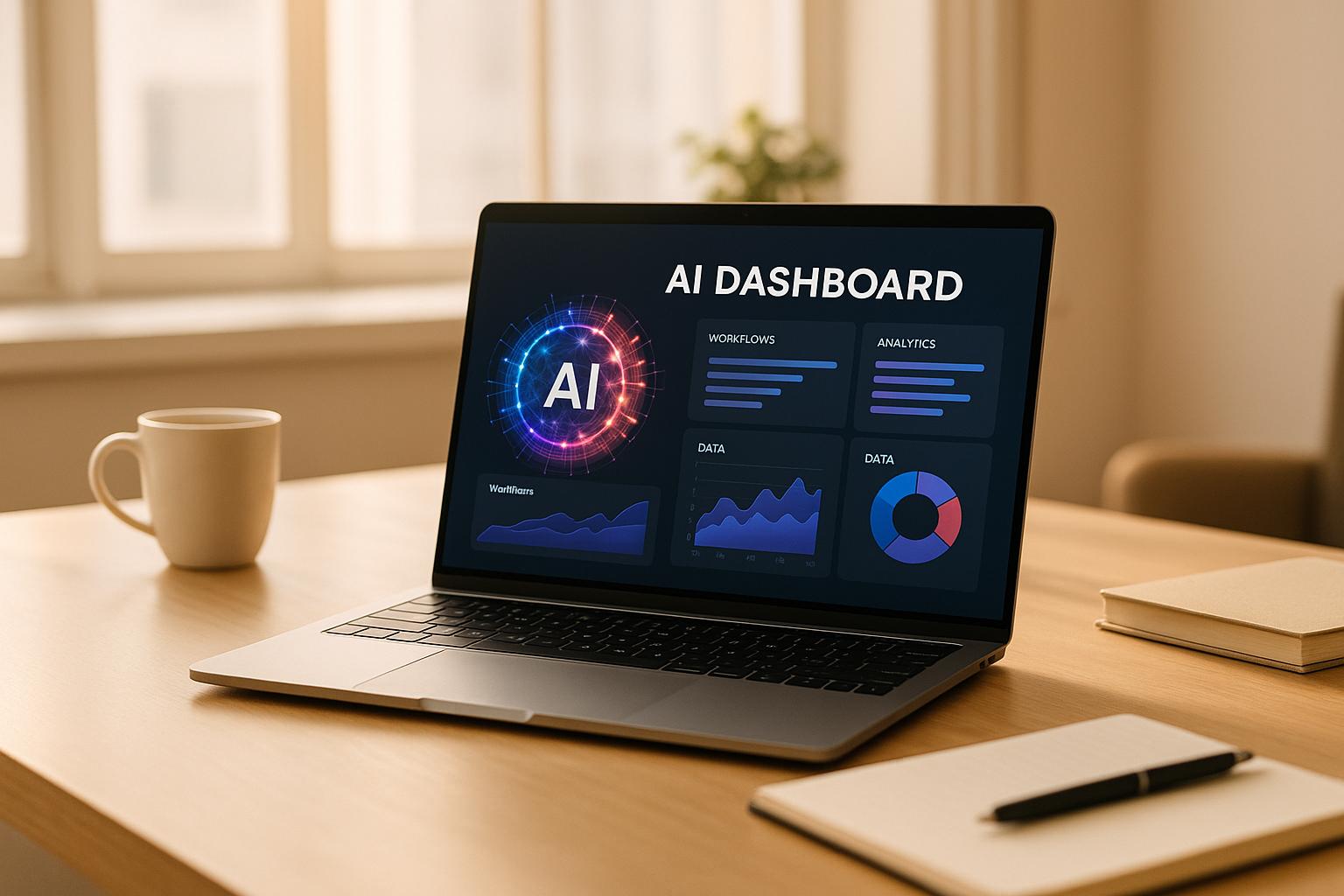
AI workflow platforms are changing how businesses integrate and manage tools, saving costs and boosting productivity. If you're struggling with fragmented systems, data silos, or high expenses, choosing the right platform is critical. Here's what you need to know:
Choosing the right platform depends on your goals, team expertise, and budget. For cost-effective language model workflows, Prompts.ai stands out. Enterprises with existing cloud investments might lean toward AWS, Google Cloud, or Azure. Smaller teams may prefer UiPath or Automation Anywhere for ease of use, while technically skilled teams might find Apache Airflow’s flexibility unmatched.
| Platform | Key Strengths | Primary Weaknesses |
|---|---|---|
| Prompts.ai | Cost savings, 35+ LLMs, unified tools | Limited to language models |
| AWS AI | Scalability, security, vast ecosystem | Complexity for smaller teams |
| Google Cloud AI | ML operations, BigQuery integration | Steep learning curve |
| Microsoft Azure AI | Enterprise integration, governance | Microsoft-centric, less flexible |
| UiPath | RPA + AI, user-friendly | High licensing costs |
| Automation Anywhere | Cloud-native, process mining | Overkill for simple tasks |
| Workato | Easy app integration, recipes | Limited AI model management |
| Apache Airflow | Open-source, full customization | Requires technical expertise |
Start with your priorities - cost, scalability, or ease of use - and match them to the platform that fits your needs.

Prompts.ai is an enterprise-level AI orchestration platform that unifies over 35 top-tier large language models, including GPT-5, Claude, LLaMA, and Gemini, into a single, secure interface. This streamlined approach enables smooth integration and simplifies workflow automation.
The platform’s standout feature is its ability to consolidate AI tools, eliminating the need for juggling multiple subscriptions. By addressing the issue of data silos - where departments rely on disconnected tools - prompts.ai helps organizations unlock the full potential of AI across their operations.
Another key feature is direct model comparison, which allows teams to test and evaluate various AI models side by side. This functionality is particularly useful for organizations needing to identify the most effective models for specific tasks before committing to large-scale implementation.
Prompts.ai doesn’t just integrate tools; it accelerates productivity with automated workflows. The platform includes pre-designed workflows, branded as "Time Savers", which embed best practices into repeatable, standardized processes. To ensure teams get the most out of these tools, prompts.ai offers a Prompt Engineer Certification program, empowering internal staff to lead AI initiatives and maximize returns on investment.
Prompts.ai can slash AI software expenses by as much as 98% through subscription consolidation. Its Pay-As-You-Go TOKN credit system ensures costs are tied directly to usage, eliminating the burden of fixed monthly fees. The platform also delivers real-time cost tracking, giving finance teams complete visibility into spending and enabling better control over AI-related budgets.
Built with enterprise-grade governance, prompts.ai ensures that sensitive data remains secure during AI processing. For organizations navigating strict compliance standards, the platform provides detailed audit trails for every workflow, making it easier to meet regulatory requirements.
Additionally, real-time monitoring offers insights into how AI models are being used, by whom, and for what purposes. This level of transparency bolsters both security and operational efficiency, ensuring that AI usage aligns with organizational policies.
Prompts.ai is built to scale effortlessly, allowing organizations to add new models, users, and teams in just minutes without disrupting existing workflows. The platform’s adaptability supports growth, from small creative teams to large enterprises, including Fortune 500 companies.
Its tiered pricing structure accommodates businesses of all sizes, while the community-driven network of prompt engineers offers ongoing support and shared expertise, helping organizations expand their AI capabilities confidently and efficiently.
Amazon Web Services (AWS) provides a suite of tools for building AI workflows, with Amazon Bedrock and AWS Step Functions at the forefront. These tools enable businesses to manage complex, multi-step processes seamlessly across various applications.
AWS simplifies the integration of diverse AI models and external systems through a unified framework. Amazon Bedrock offers access to foundation models from top AI providers like AI21 Labs, Anthropic, Cohere, Meta, Mistral AI, and Stability AI - all accessible via a single API. This unified approach reduces the complexity of incorporating AI into applications.
To enhance flexibility, Amazon Bedrock Knowledge Bases support integration with a variety of vector storage databases. This includes third-party options such as Pinecone and Redis Enterprise Cloud, with planned support for Amazon Aurora and MongoDB to further enable Retrieval Augmented Generation (RAG) workflows.
AWS Step Functions adds another layer of composability, offering seamless integration with over 9,000 AWS API actions from more than 200 services. It also supports third-party APIs using HTTP Task states, making it easier to connect systems and automate processes.
"At AWS, we're committed to being the best place to build the world's most useful AI agents, empowering organizations to deploy reliable and secure agents at scale." - Swami Sivasubramanian, VP, AWS Agentic AI
AWS takes automation to the next level with tools designed to handle multi-step tasks effortlessly. Amazon Bedrock Agents can automate operations across systems, APIs, and data sources. These agents are capable of accessing tools, interacting with data, and utilizing the internet to manage complex tasks. They can also collaborate with other agents, ensuring comprehensive workflow automation.
The Amazon Bedrock AgentCore enables the secure deployment of AI agents at scale, regardless of the framework or model used. This provides businesses with the flexibility to choose their preferred AI technologies while maintaining high levels of security and performance.
AWS services ensure that workflows remain adaptable, allowing businesses to easily connect external tools, systems, and data as their needs evolve.
AWS caters to enterprise-level demands with solutions designed to grow alongside AI strategies. Through the AWS Marketplace, businesses can access hundreds of AI agents, tools, and solutions from AWS Partners. This ecosystem allows organizations to start small and expand their AI capabilities over time.
Additionally, AWS is exploring open protocols like the Model Context Protocol (MCP) to support agent-to-agent communication and enhance interoperability. This forward-thinking approach ensures businesses can scale their AI initiatives efficiently while staying ahead of technological advancements.

Google Cloud AI takes an open approach to orchestrating workflows through its Agent2Agent (A2A) protocol. This protocol enables AI agents to communicate, securely share information, and coordinate tasks across diverse enterprise systems. It establishes a framework for smooth integration, automation, and security throughout all stages of a workflow.
The A2A protocol emphasizes open and flexible integration, aligning with the need for unified orchestration. Built on widely-used web standards like HTTP, Server-Sent Events (SSE), and JSON-RPC, it ensures compatibility with a range of IT infrastructures. Its design supports multiple formats - text, audio, and video - making it adaptable to various communication needs. Additionally, its automation features simplify and streamline AI operations.
Whether handling quick tasks or managing extended processes, the A2A protocol ensures real-time updates and coordination. By fostering collaboration among multiple AI agents, it boosts efficiency and helps reduce operational costs.
Security is central to the A2A protocol. It employs strong authentication and authorization measures to ensure that all communications between AI agents are protected and compliant with enterprise security standards.
The A2A protocol is built to handle the demands of scalable AI operations. It facilitates seamless collaboration in complex environments, enabling efficient interoperation within a multi-agent ecosystem.
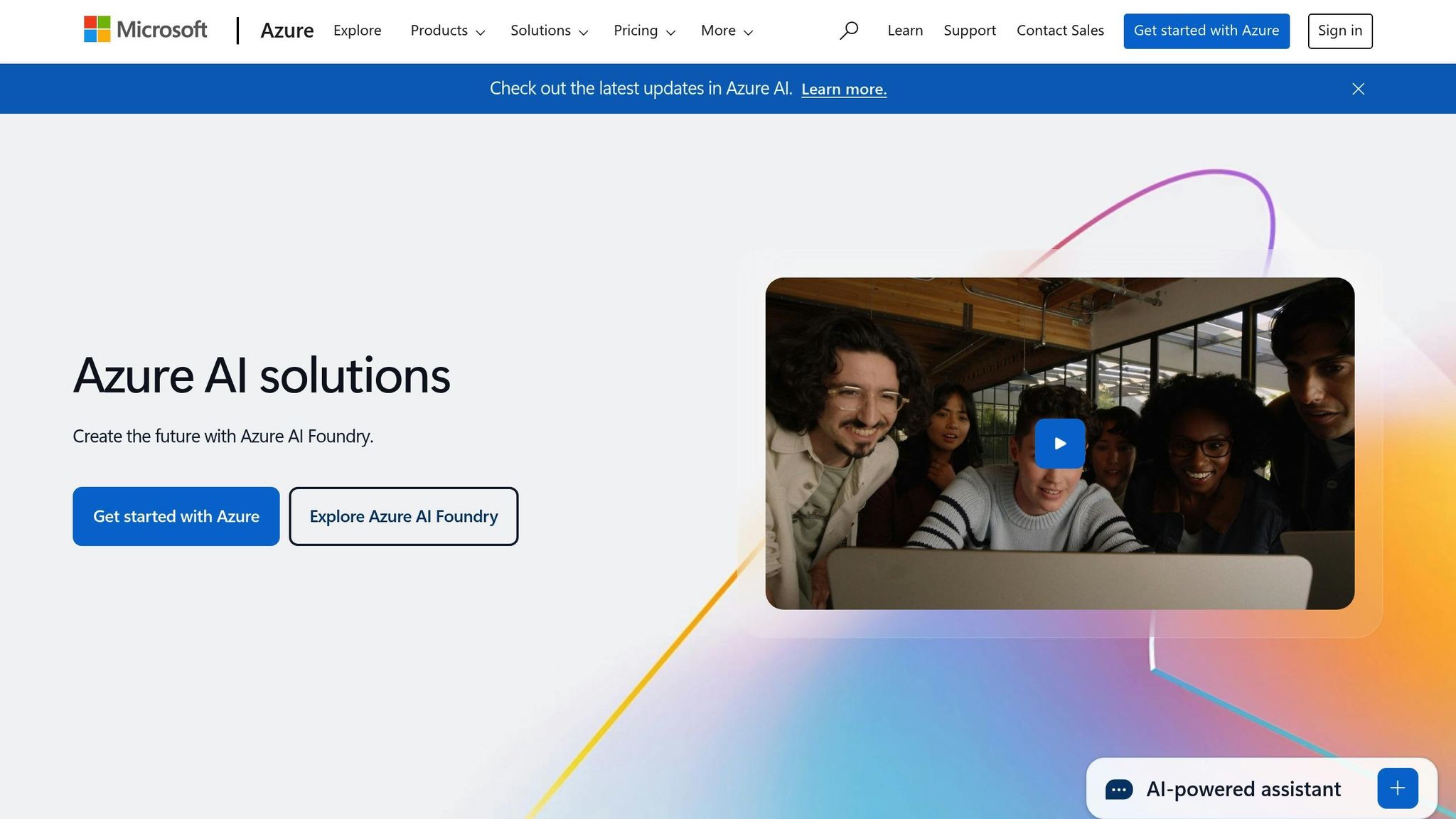
Microsoft Azure AI brings together a suite of tools like Azure Machine Learning, Logic Apps, and Power Platform to simplify the entire AI workflow - from preparing data to deploying and monitoring models.
Azure AI is designed to connect various systems through a hybrid cloud setup and pre-built connectors for Microsoft 365, on-premises Active Directory, and third-party apps. Developers can also take advantage of its REST APIs and SDKs, which support popular programming languages such as Python, R, C#, and Java, making it adaptable for diverse teams.
Azure Logic Apps acts as the backbone for workflow orchestration, featuring an intuitive visual designer that simplifies building complex business processes. The platform accommodates both code-first and low-code approaches, fostering collaboration between technical and non-technical users alike. Logic Apps can initiate workflows based on schedules, data updates, or external triggers, all while offering built-in error handling and automatic retries.
Azure Machine Learning pipelines streamline the machine learning lifecycle by automating tasks like data ingestion and model retraining. These pipelines adapt to changes in data patterns and include MLOps features for automated testing, version control, and efficient deployment. Together, these tools pave the way for cost-effective and secure AI operations.
Azure AI operates on a consumption-based pricing model, ensuring costs align with actual compute usage. Features like Azure Spot Virtual Machines help reduce expenses for workloads that don’t require immediate processing by utilizing available capacity. Reserved Instances provide additional savings for predictable tasks. Azure's cost management tools offer detailed analytics and budget alerts, helping teams track and optimize their AI spending.
Security is a core focus for Azure AI, which integrates with Azure Active Directory for single sign-on and multi-factor authentication. Data is encrypted both during transfer and at rest using industry-standard protocols, and customer-managed encryption keys are available for those with stringent security needs. Azure Policy ensures compliance by enabling automated monitoring for regulations like GDPR, HIPAA, and SOC 2. Additionally, Private Link allows organizations to access Azure AI services via private network connections, keeping sensitive data off the public internet.
With a global infrastructure spanning over 60 regions, Azure AI ensures that organizations can deploy workflows close to their data and users. Serverless options like Azure Functions automatically scale with demand, removing the burden of capacity planning. For containerized workloads, Azure Kubernetes Service (AKS) adjusts scaling based on resource usage or custom metrics. This flexibility supports everything from small-scale projects to enterprise-wide AI deployments, making Azure AI a robust choice for scaling AI workflows seamlessly.
This scalability ensures Azure AI can meet the demands of businesses at every stage of their AI journey.
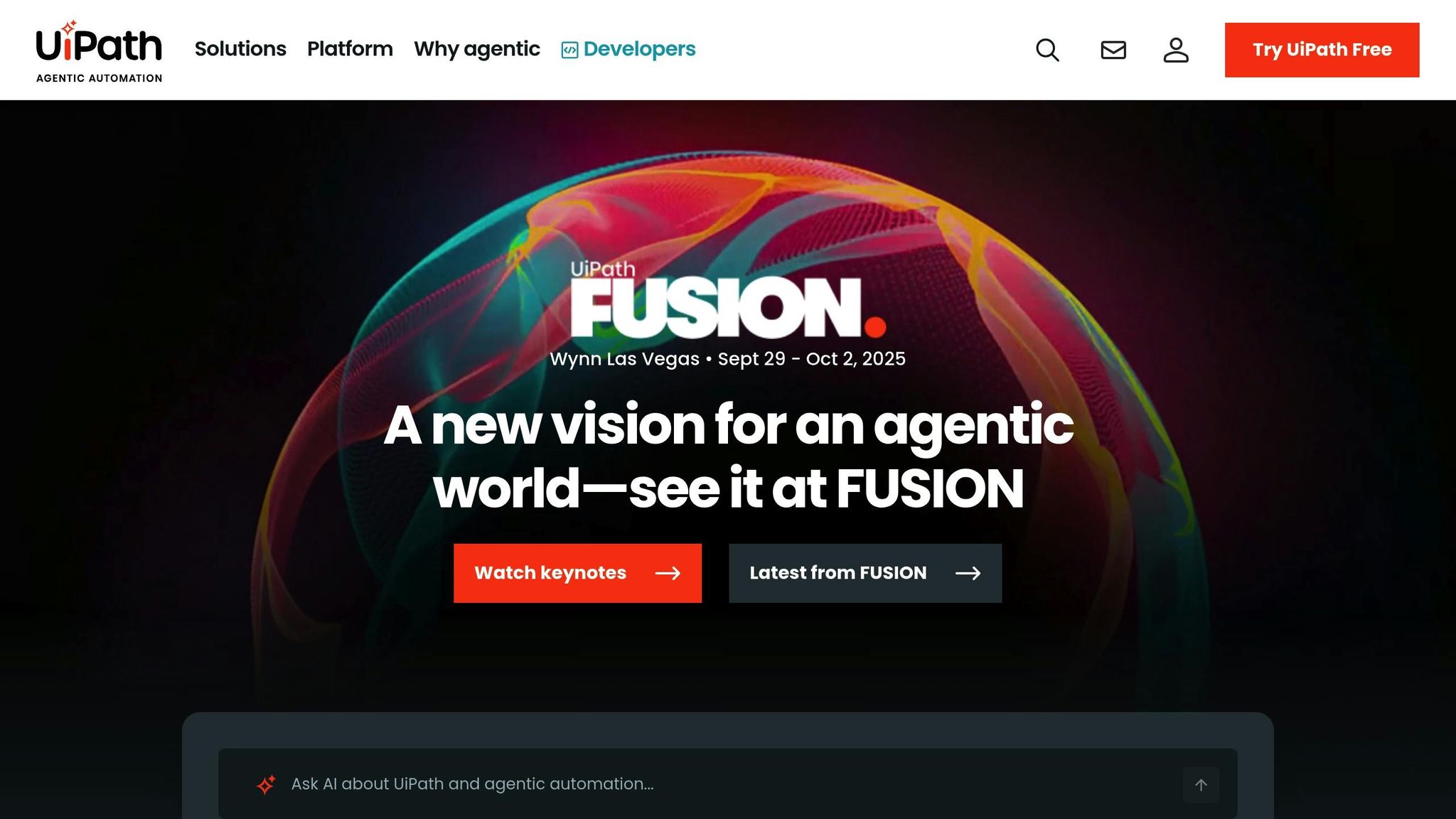
UiPath combines robotic process automation (RPA) with advanced AI to deliver a powerful automation platform. By orchestrating AI agents, robots, and human expertise, it handles complex workflows that demand both precision and adaptability.
UiPath stands out by seamlessly connecting a variety of AI technologies and enterprise systems, thanks to its open architecture. It can integrate agents from providers like OpenAI, Google, Nvidia, and Microsoft, giving organizations the flexibility to select the best AI models while maintaining centralized control. This capability aligns with the priorities of 87% of U.S. IT executives who value interoperability in their tech solutions.
With over 70 prebuilt AI models and integrated GPT capabilities, UiPath simplifies AI adoption, cutting down the time needed for implementation. At the heart of this system lies the AI Center, which acts as the command hub for managing integrations, enabling smooth building, deployment, and optimization of machine learning models. These features create a solid foundation for efficient automated workflows.
UiPath Maestro serves as the platform's centerpiece for unifying AI agents, robots, and tools into cohesive automation workflows. By combining RPA with API connectors, intelligent document processing (IDP), and no-code app design, UiPath merges adaptability with robotic accuracy.
Key features include UiPath Agents, which support low-code, conversational, and pro-code development, and UiPath Screenplay, which enables natural language automation creation. Advanced document processing further enhances the platform's ability to automate intricate workflows.
The platform's effectiveness is evident in real-world applications. For instance, in September 2025, WEX saved $2.7 million by streamlining its operations through UiPath's automation capabilities. This involved consolidating processes, automating workflows, and enabling agents to use natural language in call centers. Similarly, ApprioHealth leveraged UiPath automation and AI Computer Vision to handle larger data volumes, speeding up payment cycles.
Will Hamilton, VP of Business Line Development at ApprioHealth, highlighted how their digital workforce now manages more accounts while shortening the collection lifecycle.
UiPath helps organizations cut costs by automating tasks that previously required human effort. By combining RPA's precision with AI's flexibility, it reduces labor expenses while boosting accuracy and speed.
The platform's drag-and-drop interface and prebuilt AI models further reduce development time and costs. Additionally, it allows organizations to integrate AI tools from multiple providers, avoiding vendor lock-in and enabling cost-effective model selection.
UiPath prioritizes security and governance for AI-powered automation. Features like agent guardrails ensure AI operates within set boundaries, while content moderation filters inappropriate or sensitive material. Unified auditing tools provide comprehensive oversight for all automations.
For example, mediba, a Japanese digital media company, used UiPath AI Center to manage keywords on its web portal. This automated solution filtered obscene or objectionable content, replacing a previously manual and time-consuming process.
UiPath is designed to scale from small projects to enterprise-wide automation. Its architecture supports growth, allowing organizations to start with specific use cases and expand over time. By orchestrating multiple AI providers and integrating seamlessly with existing systems, UiPath enables businesses to scale without significant additional resources.
Heritage Bank, Australia's largest mutual bank, used UiPath AI Center to improve its loan review process, reducing backend workloads while enhancing both customer and employee experiences. In the healthcare sector, a major health insurance company collaborated with Amitech Solutions to streamline clinical outcomes using UiPath AI Center and Document Understanding, saving time and improving patient care.
UiPath's low-code and no-code capabilities make it accessible to both technical and non-technical users, ensuring that scaling automation doesn't require a proportional increase in technical staff. This approach makes the platform suitable for organizations at varying levels of technical expertise.
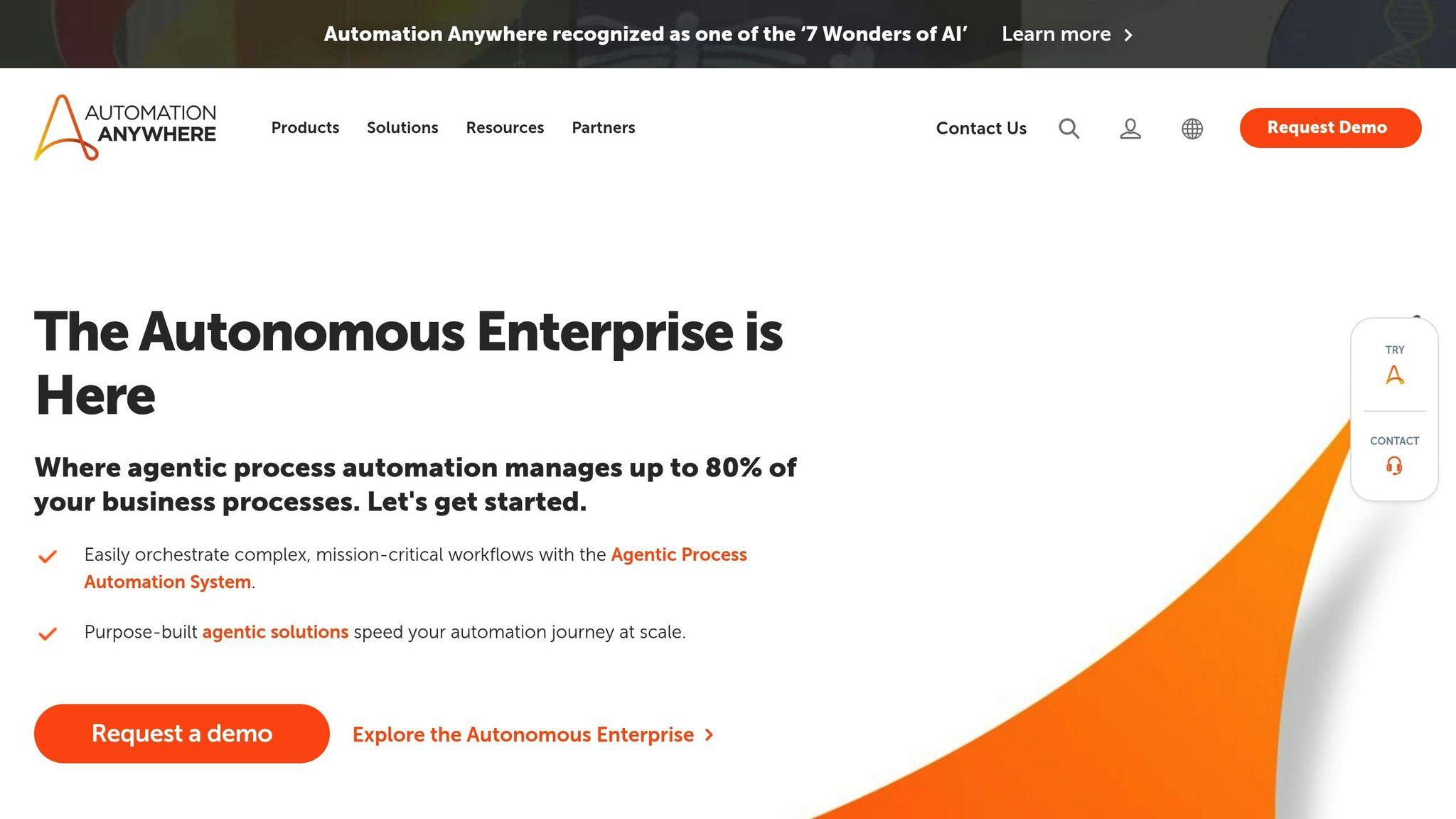
Automation Anywhere delivers a cloud-native platform designed for robotic process automation (RPA) and AI-driven workflows. Its intuitive interface and cloud-based architecture aim to make automation accessible to a broad range of users.
Automation Anywhere integrates effortlessly with enterprise systems thanks to pre-built connectors and APIs. It connects with major platforms like SAP, Salesforce, and leading cloud providers, alongside AI tools such as natural language processing and computer vision technologies.
The platform's Bot Store offers a library of over 850 pre-built automations and integrations. This marketplace enables businesses to adopt automation quickly without the need for extensive custom development, making it easier to implement proven solutions.
With its Discovery Bot, Automation Anywhere leverages process mining to analyze workflows and identify automation opportunities. This feature provides insights into how current tools and systems interact, laying the groundwork for AI-driven workflow improvements. These integrations simplify the adoption of streamlined, data-informed automation processes.
Automation Anywhere enhances workflow visibility through its Bot Insight analytics engine. This tool delivers real-time performance data, helping organizations optimize processes by tracking metrics like processing times, error rates, and resource usage.
The IQ Bot feature tackles unstructured data with cognitive automation capabilities. It extracts information from documents, emails, and other sources, feeding that data into downstream workflows for further processing and decision-making.
The platform supports both attended and unattended automation, allowing workflows to run autonomously or with human input. This flexibility ensures compatibility with existing processes without requiring significant changes.
Automation Anywhere uses a consumption-based pricing structure, aligning costs with actual usage. This model is particularly advantageous during the early stages of implementation when usage patterns may vary.
For small businesses and individual developers, the Community Edition offers free access to basic automation tools. This includes entry to the Bot Store and development features, allowing users to explore automation without initial financial commitments.
The platform’s Center of Excellence (CoE) framework helps organizations establish governance practices, preventing duplicated efforts and ensuring resources are allocated effectively across automation projects.
Security is a priority for Automation Anywhere, which meets SOC 2 Type II certification and complies with GDPR, HIPAA, and PCI DSS standards. Its cloud-native architecture includes built-in safeguards such as end-to-end encryption, role-based access controls, and comprehensive audit trails for all automated processes.
The Credential Vault securely manages authentication details for integrated systems, reducing the risk of exposing sensitive information. This centralized approach simplifies credential management while enhancing security.
With Bot Runner technology, automation execution environments are isolated, minimizing the risk of security breaches spreading across systems. This containment strategy is especially critical for workflows handling sensitive data or interacting with essential business systems.
Automation Anywhere’s cloud-native design supports seamless scaling to meet growing demands. Resources adjust automatically based on workflow needs, eliminating the need for manual infrastructure provisioning. The platform can handle thousands of concurrent automations across different regions.
The Control Room serves as a centralized hub for managing automation activities. Administrators can deploy, monitor, and scale workflows efficiently, ensuring consistent oversight as automation efforts expand.
Through its Digital Workforce concept, Automation Anywhere enables the creation of virtual teams of software bots. These bots can be assigned to various departments or projects, allowing businesses to reallocate resources quickly to adapt to shifting priorities or seasonal changes. This flexibility reinforces its role as a comprehensive solution for managing AI workflows from end to end.
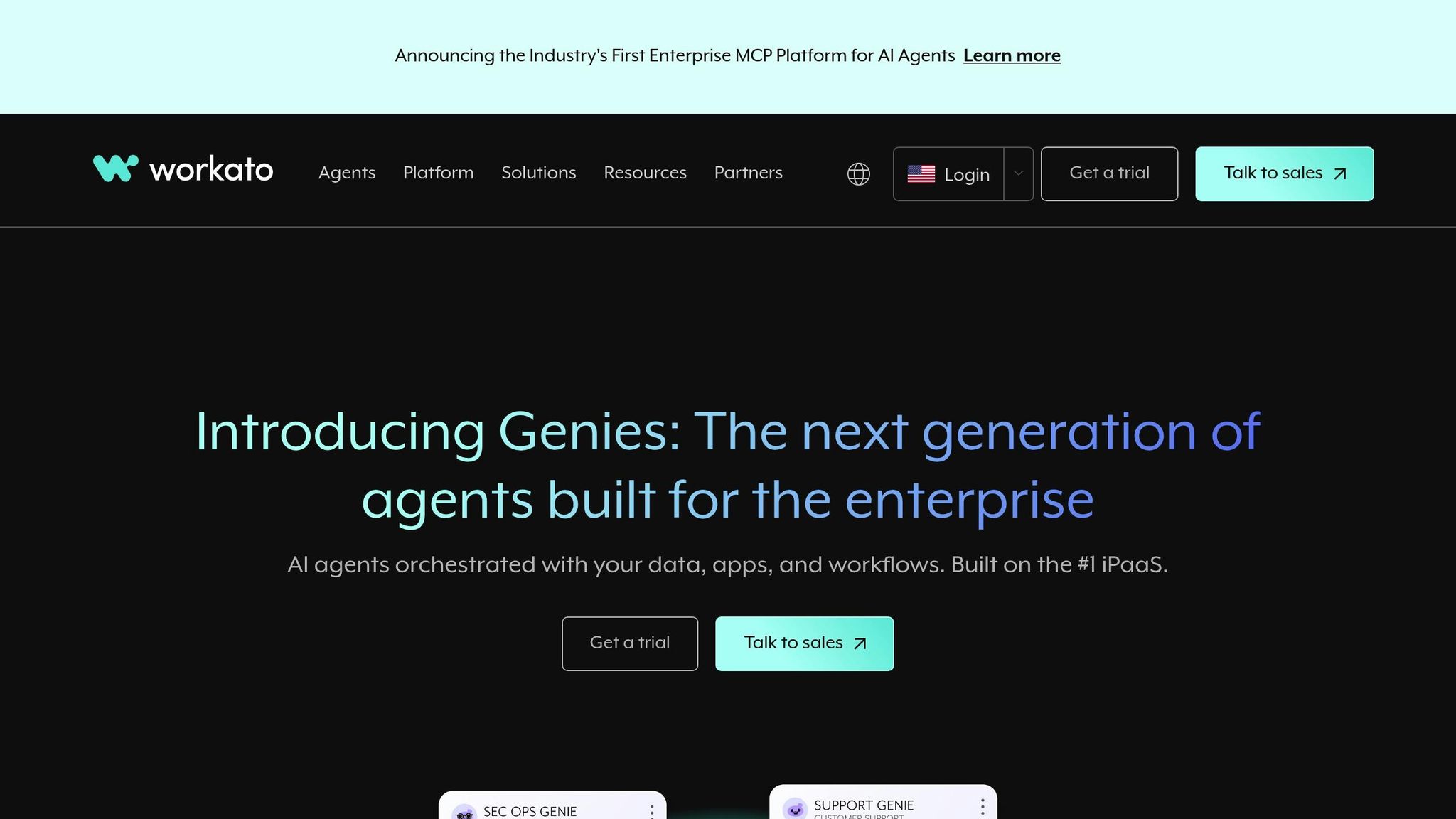
Workato brings together business applications and streamlines workflows, all while minimizing technical complexity.
Workato offers an extensive library of connectors that integrate enterprise applications, cloud services, and databases. It works seamlessly with widely used tools like Salesforce, ServiceNow, NetSuite, and Workday. Using its recipe-based system, users can create workflows across platforms without writing any code. For instance, a recipe could automatically generate a customer record in a CRM system when a new order is placed in an e-commerce platform, then synchronize the data with an ERP system. The platform also supports custom APIs and legacy systems through its universal connector framework, making it highly adaptable for diverse integration needs.
With a visual drag-and-drop builder, Workato allows users to design automations effortlessly. The platform handles tasks like data transformation and error management on its own, while its conditional logic engine enables the creation of complex workflows. Real-time monitoring and analytics, accessible through detailed dashboards, help users keep track of performance and resolve issues quickly. These advanced automation capabilities not only simplify processes but also contribute to cost savings.
Workato uses a task-based pricing model, which can be particularly beneficial for organizations with extensive automation requirements. Its reusable recipe components speed up development and make scaling automation more efficient. By empowering business users to create and manage workflows independently - thanks to its citizen integrator approach - Workato reduces the need for heavy IT involvement, cutting down operational costs.
Security is a priority for Workato, which offers encryption for data both in transit and at rest, along with comprehensive audit logs for workflow activities. The platform adheres to recognized security standards and provides data residency options to help organizations comply with regulations. Role-based access controls ensure that only authorized personnel can create, modify, or execute workflows, protecting sensitive processes from unauthorized changes.
Workato’s cloud-native design ensures it can scale effortlessly to meet the needs of enterprises of all sizes. Its workspace management feature allows businesses to separate development, testing, and production environments, ensuring experimental workflows don’t disrupt essential operations. Additionally, embedded integration capabilities let Workato integrate directly into existing business applications, delivering a seamless automation experience across the enterprise’s technology landscape.
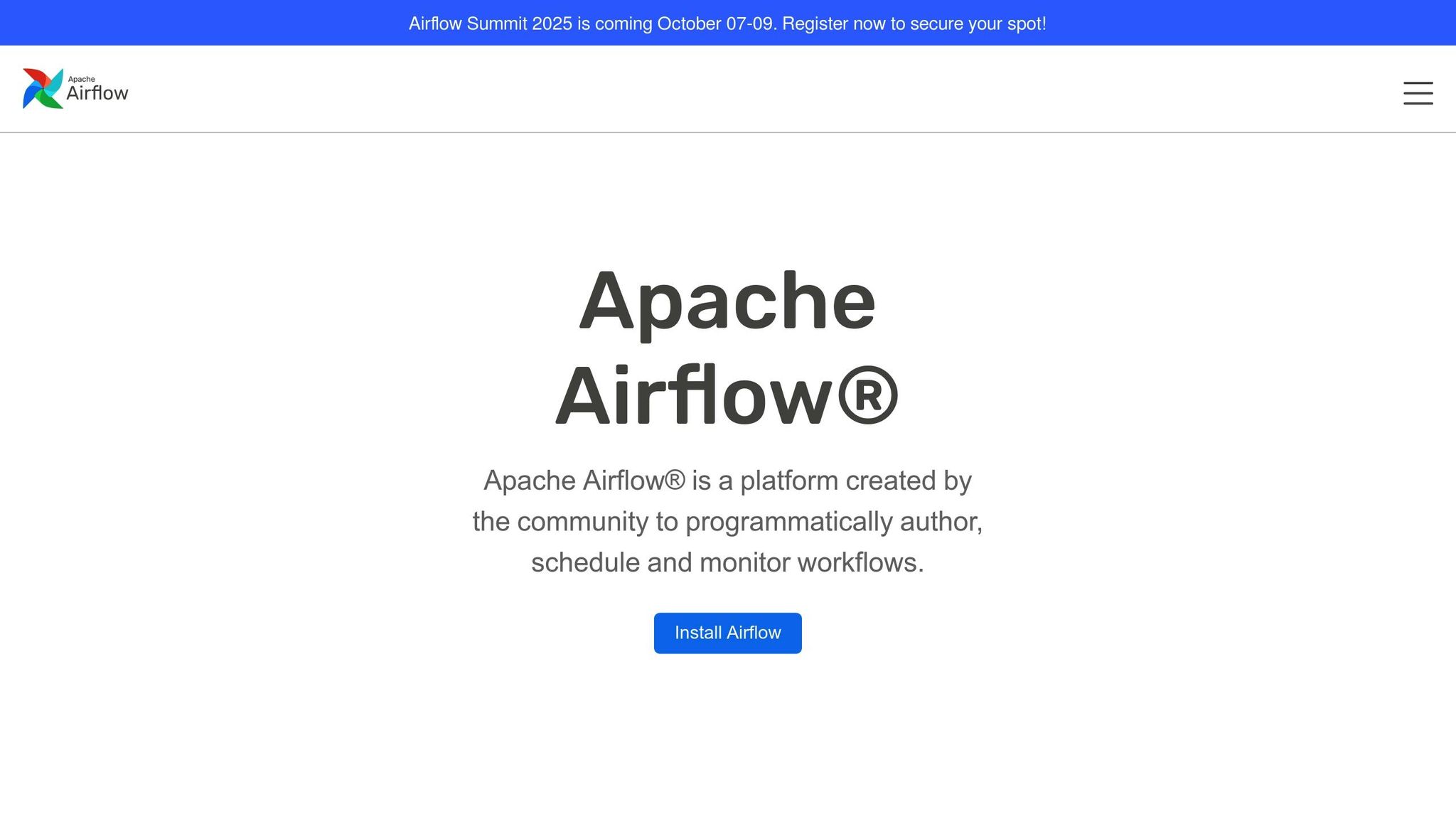
Apache Airflow is a robust open-source platform designed for programmatic control of AI workflow orchestration. According to the Apache Airflow documentation:
"Apache Airflow® is an open-source platform for developing, scheduling, and monitoring batch-oriented workflows. Airflow's extensible Python framework enables you to build workflows connecting with virtually any technology".
This adaptability makes it a strong choice for organizations managing diverse AI pipelines. Unlike platforms that rely on pre-built visual tools, Airflow leans on developer expertise to create customized orchestration solutions. Its ability to seamlessly integrate with various tools further enhances its role in unifying AI workflows.
One of Airflow's key strengths lies in its ability to connect a wide range of AI tools and platforms through an extensive library of operators. It provides ready-to-use operators for major platforms like Google Cloud, AWS, and Microsoft Azure. Additionally, tools such as the Astronomer's Cosmos provider allow Airflow to unify data transformations while offering clear visibility into dbt tasks .
For ELT workflows, Airflow integrates seamlessly with Databricks using the Airflow Databricks provider. This integration enables workflows to extract data from CSV files stored in S3, load it into Databricks Delta Lake tables, and execute transformations through Databricks jobs - entirely managed and scheduled by Airflow.
Airflow goes beyond simple connectivity, offering developers the tools to automate workflows with precision. Its Python-based framework provides full control over workflow logic and scheduling, allowing developers to define workflows in code. This flexibility supports the orchestration of complex AI workflows tailored to specific needs.
Real-world examples highlight its impact across industries. In financial services, Airflow orchestrates workflows for fraud detection by curating data to train and retrain machine learning models that flag anomalies. In retail and e-commerce, it powers recommendation engines and personalized marketing campaigns by managing data pipelines that analyze customer behavior. In healthcare, Airflow supports the training of machine learning models for analyzing medical imagery, aiding in diagnostics.
Airflow's capabilities shine in generative AI applications. The Generative AI cookbook for Apache Airflow provides a practical framework for deploying AI solutions across six common use cases, including support automation, e-commerce product discovery, and legal document summarization. It integrates seamlessly with embedding and inference models, vector databases, distributed compute platforms, and cloud services, ensuring reliable delivery of AI applications.
This section summarizes the essential strengths and limitations of each platform, helping you choose based on your technical needs and budget.
prompts.ai stands out for its exceptional cost savings - potentially reducing AI software expenses by up to 98% - and access to over 35 language models. Its unified interface simplifies operations by eliminating tool sprawl and providing real-time FinOps controls for transparent cost management. However, its focus on language models may limit its usefulness for organizations requiring broader AI capabilities.
AWS AI Workflow Tools offer unmatched scalability and secure workflow integration within the extensive AWS ecosystem. For organizations already using AWS infrastructure, the platform provides seamless connectivity and robust security. Its vast service catalog supports complex enterprise workflows, but smaller teams may find the platform's breadth overwhelming and its complexity challenging.
Google Cloud AI Workflow Tools shine in machine learning operations and data analytics, particularly with BigQuery integration and AutoML capabilities. These features make it valuable for data-driven organizations. However, teams without prior Google Cloud experience may face a steep learning curve due to its specialized ecosystem.
Microsoft Azure AI Workflow Tools deliver strong enterprise integration, offering immediate benefits for organizations already embedded in the Microsoft ecosystem. Features like Office 365 connectivity and cognitive services enhance its appeal, but businesses with diverse technology stacks may find its Microsoft-centric approach limiting.
UiPath excels in robotic process automation (RPA) with its intuitive drag-and-drop interface, making automation accessible even to non-technical users. Its enterprise-grade features support large-scale deployments, but high licensing costs and potential over-engineering could be drawbacks for simpler automation needs.
Automation Anywhere simplifies bot lifecycle management with built-in governance tools and a cloud-native architecture. AI-powered discovery tools accelerate automation implementation, but its advanced features may be unnecessarily complex for straightforward tasks.
Workato integrates hundreds of applications with minimal setup, using a recipe-based approach to simplify complex workflows. While it ensures enterprise-grade security, its primary focus on integration workflows may not fully address AI model management requirements.
Apache Airflow provides unmatched customization through its open-source Python-based framework, giving development teams full control without licensing fees. However, this flexibility demands significant technical expertise and ongoing maintenance, which could strain resources.
The table below highlights the key points for each platform:
| Platform | Key Strengths | Primary Weaknesses |
|---|---|---|
| prompts.ai | Cost savings (up to 98%), 35+ LLM access, unified interface | Limited to language models |
| AWS AI Workflow Tools | Scalability, strong security, extensive service integration | Complexity for small teams, potential vendor lock-in |
| Google Cloud AI | ML operations, BigQuery integration, AutoML capabilities | Steep learning curve, Google ecosystem dependency |
| Microsoft Azure AI | Enterprise integration, Office 365 connectivity | Microsoft-centric, limited cross-platform flexibility |
| UiPath | Visual workflow design, user-friendly, enterprise features | High licensing costs, potential over-engineering |
| Automation Anywhere | Bot management, cloud-native, AI-powered discovery | Advanced features may overwhelm simple use cases |
| Workato | Simplified app integrations, recipe-based workflows | Limited focus on AI model management |
| Apache Airflow | Full customization, open-source, no licensing fees | Requires technical expertise, ongoing maintenance |
Selecting the right platform depends on your team’s technical expertise and resources. Development-heavy teams may appreciate Airflow’s flexibility, while those looking for quick, user-friendly solutions might lean toward UiPath. For cost-conscious teams focusing on language models, prompts.ai’s streamlined approach could be the ideal choice. These trade-offs provide a foundation for making an informed decision.
Selecting the right AI workflow platform is all about understanding your organization's unique needs, technical expertise, and budget. Our analysis highlights some clear recommendations tailored to different types of businesses in the US.
For companies focused on cost-effective language model workflows, prompts.ai stands out. Its pay-as-you-go TOKN credit system ensures costs are directly tied to usage, offering transparency and eliminating recurring subscription fees. This makes it an excellent option for businesses aiming to manage expenses while integrating language models seamlessly.
Enterprise organizations with existing cloud investments should prioritize platforms that complement their current infrastructure. For those heavily using AWS, AWS AI Workflow Tools provide excellent scalability and security. Similarly, companies leveraging Microsoft services, such as Office 365, will benefit from Microsoft Azure AI, which integrates smoothly into the Microsoft ecosystem.
Organizations with a strong focus on data analytics will find Google Cloud AI Workflow Tools an excellent match. When paired with BigQuery, it handles large-scale data processing efficiently. Its AutoML and machine learning operations are particularly suited for businesses that rely on advanced analytics.
For smaller teams or those with limited technical expertise, simplicity in automation is key. UiPath offers an intuitive drag-and-drop interface, making it easy to automate workflows, though its licensing costs may be a consideration. Automation Anywhere provides a cloud-native alternative with similar ease of use, though it might be more than what's needed for smaller teams.
On the other hand, development-heavy organizations with strong technical skills will appreciate the customization and cost-efficiency of Apache Airflow. While it has no licensing fees, it does require ongoing maintenance and technical resources, making it ideal for teams with the expertise to manage it.
For businesses focused on integrating multiple applications, Workato shines with its recipe-based system. This approach simplifies the creation of workflows across various platforms with minimal effort, making it a great choice for integration-heavy operations.
Ultimately, success comes down to assessing your team's technical capabilities, budget, and key priorities. If cost and language models are your focus, prompts.ai offers a streamlined, affordable solution. For broader AI needs in complex environments, cloud-native options from AWS, Google, or Microsoft may be the better choice, even if they come with higher costs and complexity.
Lastly, always ensure your chosen platform aligns with regulatory requirements and fits your organization's operational goals and technical strengths. This alignment is crucial for achieving the best results.
To select the most suitable AI workflow platform, businesses should begin by pinpointing their specific objectives and operational needs. This involves identifying which processes require automation, the scale at which the platform will operate, and any specialized requirements tied to their industry.
When evaluating platforms, focus on pricing structures, scalability, and return on investment (ROI). Seek options that balance cost-effectiveness with the ability to meet both immediate demands and future growth. Features like seamless integrations, user-friendly interfaces, and robust support for AI-driven workflows are also crucial factors to consider.
Adopting a systematic approach can simplify the decision-making process. Start by setting clear goals, conduct in-depth research on potential platforms, and closely oversee the implementation to ensure it aligns with your strategic and financial priorities.
Prompts.ai provides a range of advantages for managing AI workflows. By automating repetitive tasks, it minimizes the likelihood of human error and allows teams to focus on higher-value, strategic initiatives. The platform also supports better decision-making by organizing operations and offering real-time insights, enabling businesses to respond quickly and with greater precision.
What’s more, Prompts.ai simplifies intricate processes by integrating effortlessly with tools you already use. This makes managing and scaling AI-powered projects far more manageable. Altogether, these features boost efficiency, drive productivity, and contribute to the success of AI initiatives.
AI workflow platforms ensure the protection of sensitive data through robust security measures like encryption, access controls, and audit trails. These tools safeguard information during processing, while also helping organizations meet regulatory requirements such as HIPAA and GDPR. By automating compliance checks, these platforms reduce the likelihood of violations and keep processes aligned with legal standards.
Many platforms also incorporate AI-powered security tools to detect and mitigate threats such as data breaches, data poisoning, or adversarial attacks. These features not only preserve data integrity but also maintain the security of workflows, ensuring they remain compliant with both legal and regulatory frameworks.


